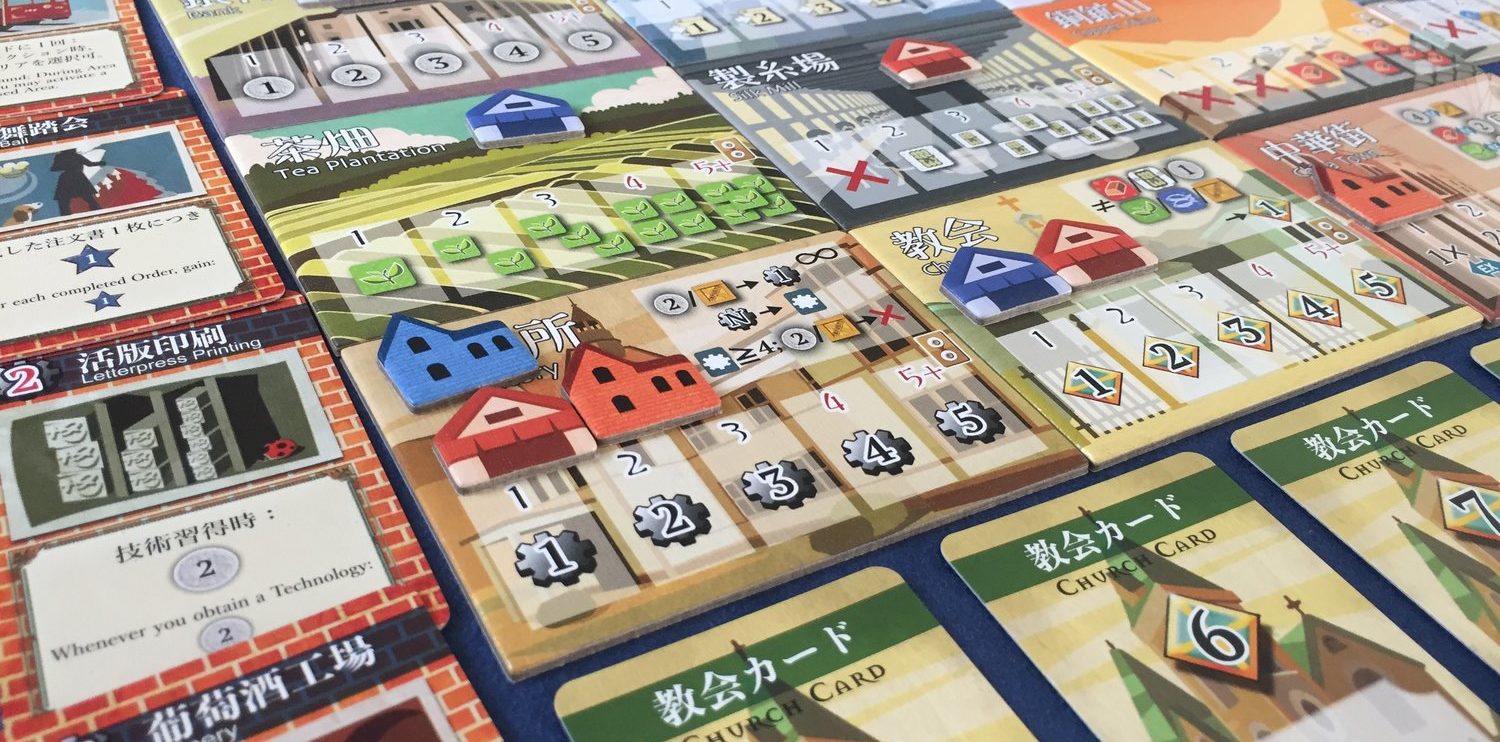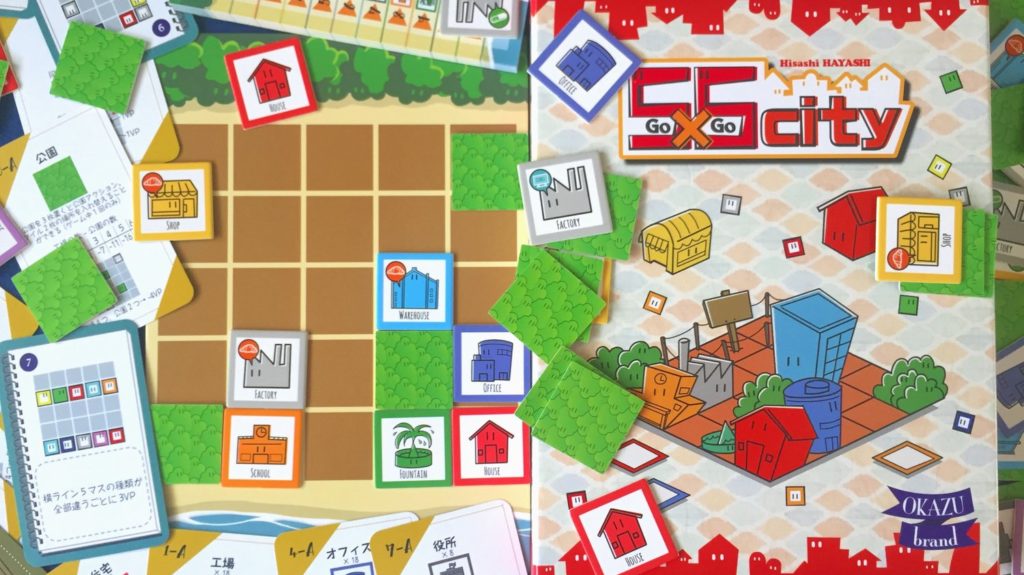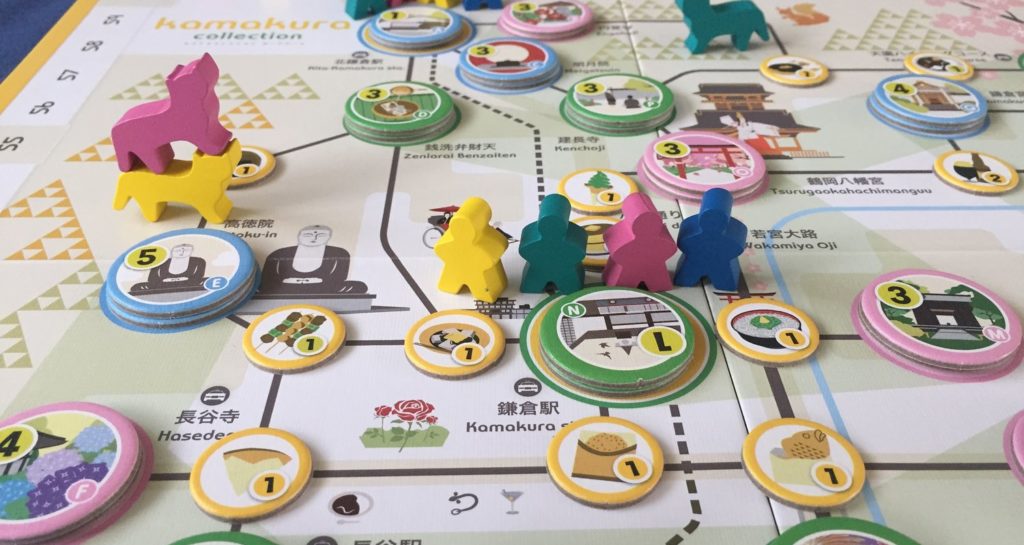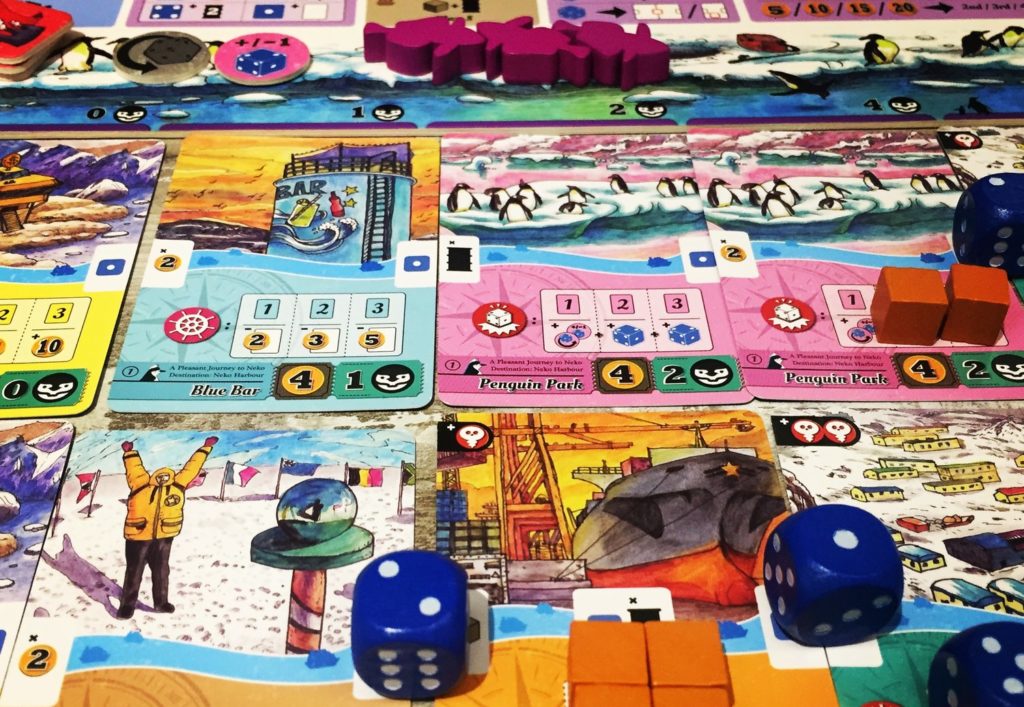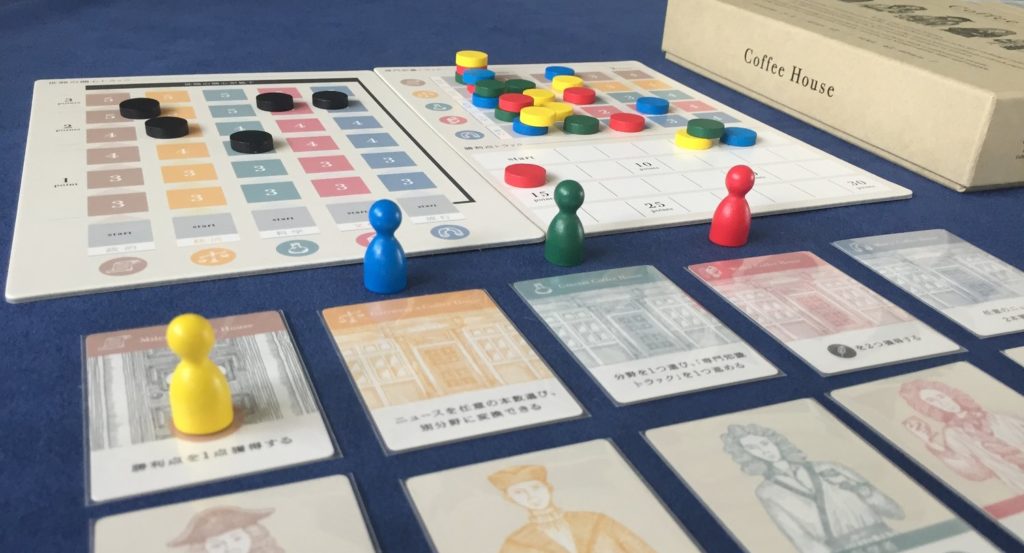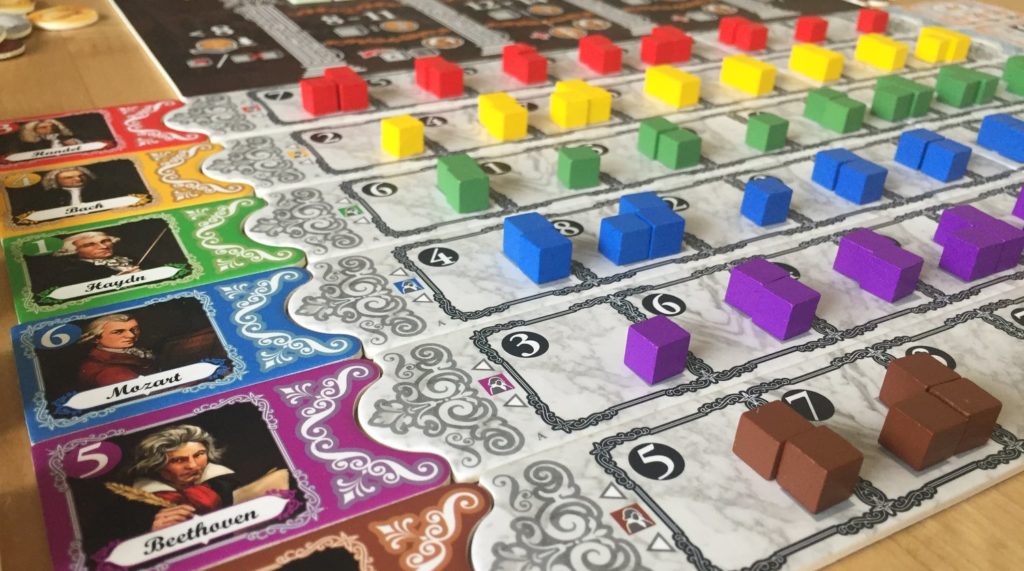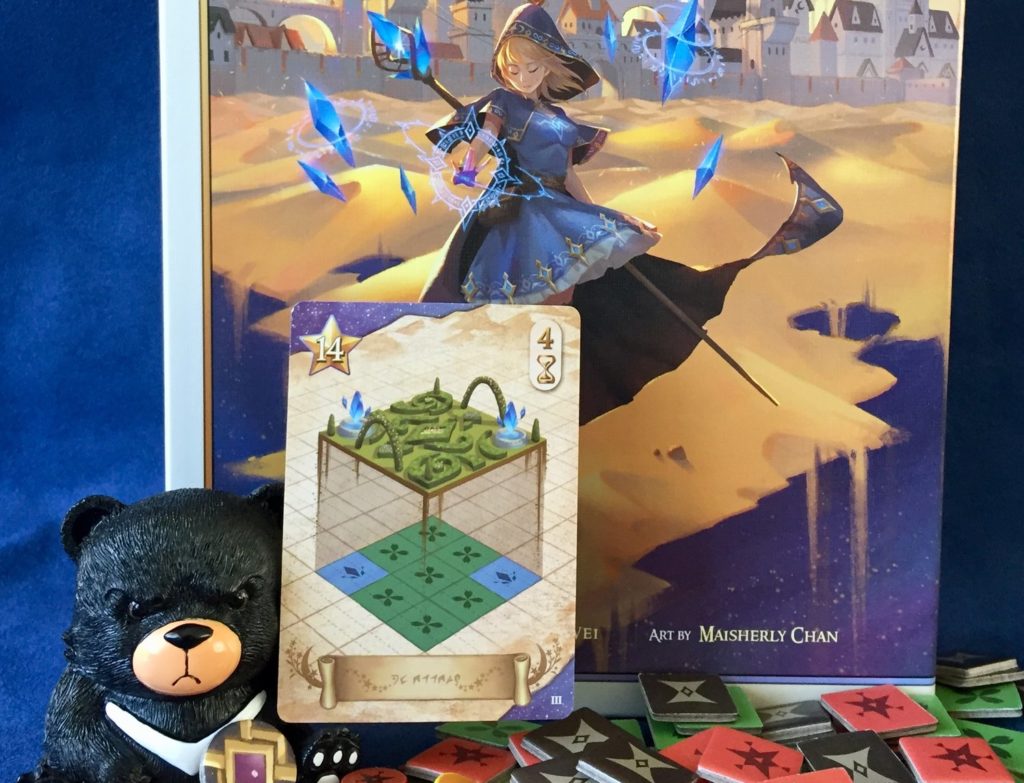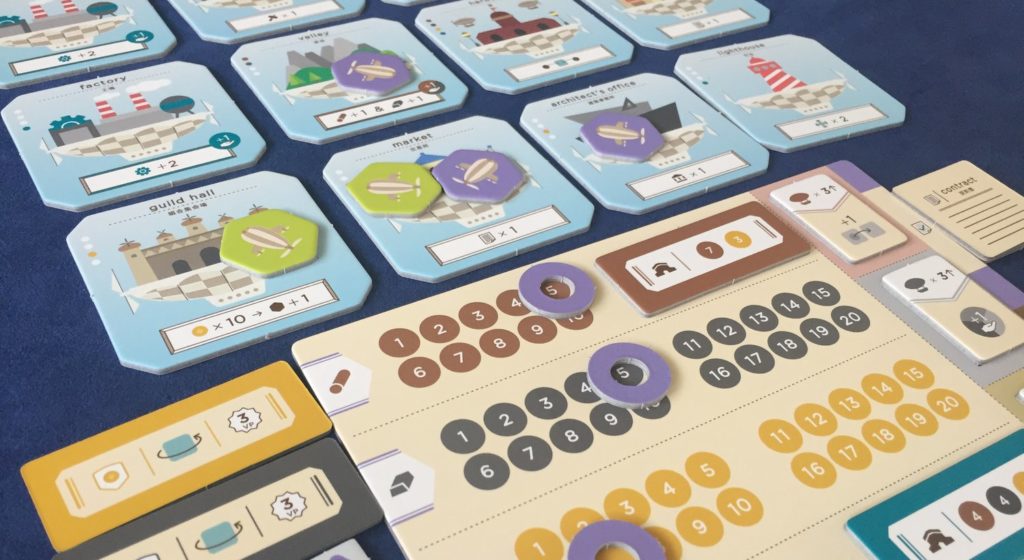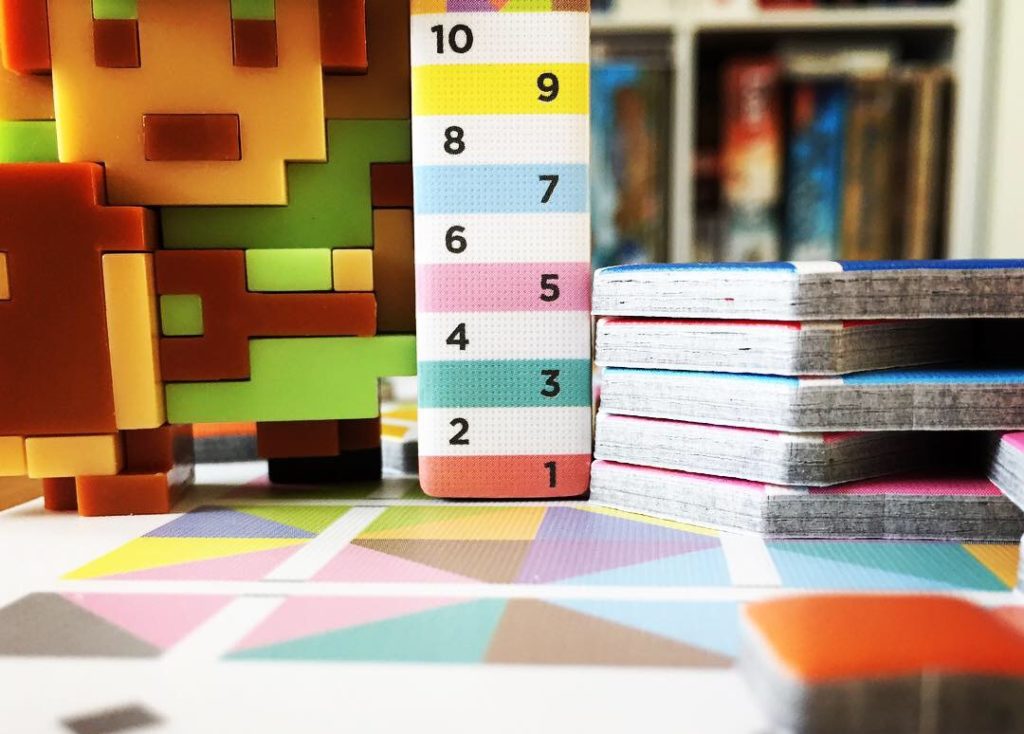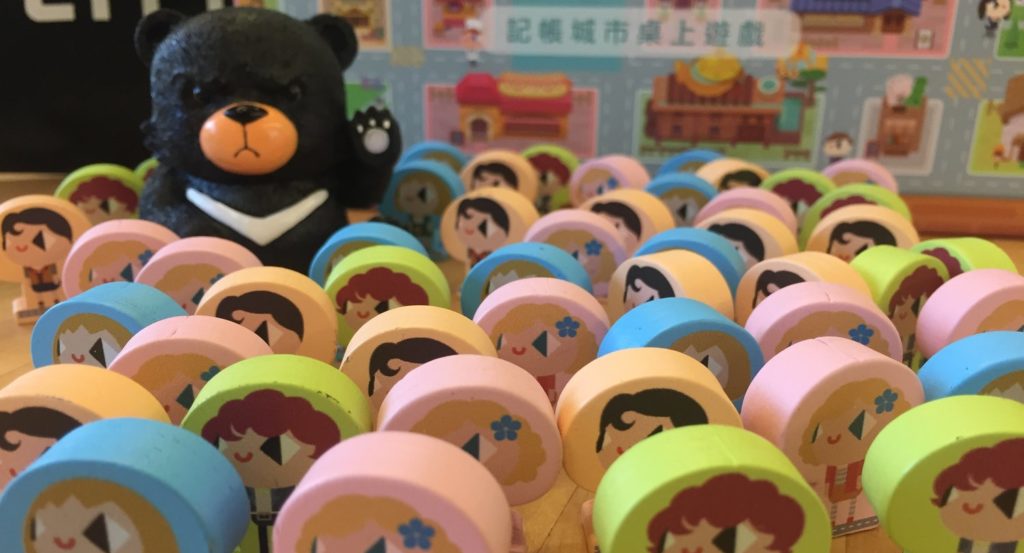2018 has been a great year for Asian board games. There were a lot of games published and a lot of them were solid games. Several successfully crossed the ocean, gained a lot of buzz, and delivered on that buzz. However before we dive into my Top 10, I want to define “Asian board game”. I define an Asian board game as any board game originally published by an Asian board game publisher, which means it wasn’t licensed by a non-Asian publisher. Ideally, it was designed and developed in Asia as well. This is important as I want to emphasize stories being told by Asian publishers. Naturally, if my criteria were only board games from Asia, then that would include almost every board game since around 5 factories in China manufacture the bulk of board games each year. Now with that out of the way, let’s get to it! Cardboard East’s Top 10 Asian board games of 2018 (out of the Asian games I have stacked like the Himalayas in CE HQ).
10. Yokohama Duel (OKAZU brand)
Yokohama (2016) remains the highest-rated Asian board game on BGG (currently ranked 92), so I was especially curious to see how this duel version would hold up. While it lacks the logistics mechanism of the original, it holds up rather well. Even though obtaining certain technologies at the right time can be quite overpowered (a problem with the original as well), I would rather play this than the original with 2 players. I would also rather play this than Istanbul with 2 players as well. YD has almost everything you love about Yokohama in under an hour. There are quite a few strategies to explore, so you should be able to get enough playthroughs of this before it begins to feel samey. The art, while functional, could have been a lot better. TMG acquired this one, so I’m curious to see the differences between the original release and the deluxified version in 2019.
9. 5×5 City (OKAZU brand) (CE variant)
OKAZU brand had several solid games this year; however, most seemed to be revisits (or revisions) of previously released games. MetroX felt like an updated Rolling Japan. Railways of Nippon was an excellent take on the Railways of the World engine—a nice tighter map was definitely needed for the series. Yokohama Duel is, well, Yokohama Light. 5×5 City feels like a streamlined update of last year’s Emperor’s Choice. I admit that this game actually should NOT be on this list. I threw this game in as a closing game for game night, skimmed through the rules, and threw this on the table. We played it wrong. We later played again correctly, and we all agreed that the Cardboard East variant was lightyears better. I misread the rules as the starting player draws the necessary tiles and creates sets via the I-cut-you-choose mechanism (criminally underused in board gaming). The original rules felt fairly uninspired, to be honest. The I-cut-you-choose variant really makes this sing. The art, while functional, looks like it was designed using Microsoft Office 95—abysmal. The gameplay is relaxing, challenging, and fun and with 12 different city layouts and different versions of each building to play with, there is a lot to explore and enjoy with 5×5 City. The CE variant adds some length to the game, but it still falls in that refreshing medium-weight filler zone, which is perfect for this game.
8. Kamakura Collection (JUGAME STUDIO)
Kamakura Collection is adorable. Without fail, after a quick rules explanation, the table is filled with smiles. Essentially, each player is playing a different Asian family in Kamakura City, a popular tourist destination in the Kanagawa Prefecture, Japan. Through action selection, the families compete to see who can plan the most efficient vacation. Can you see all the popular sights and eat at all the famous restaurants faster than everyone else? Throw in some milestones to race for, and Kamakura Collection leaps off the table. The art is simple, colorful, and refreshing. The cat meeple used for selecting actions is a great little touch as well. Don’t let all the cute art fool you though. Kamakura Collection can be vicious at times. Blocking other players happens and can be quite brutal; it really abstracts the waiting in line for attractions extremely well. Kamakura is an excellent little family game that plays under an hour. While I would have liked to have seen more milestones and personal mission cards, there are enough to add a decent amount of replayability.
7. A Pleasant Journey to Neko (The Wood Games)
There’s no other way to say it. A Pleasant Journey to Neko (APJTN) is an odd game. Not in a bad way, but I can honestly say that I’ve never played a game quite like it. There’s dice drafting, bidding, tableau/engine building, resource management, networking, logistics, an environmental message, penguins, and fish—lots and lots of fish. Best of all, it works—really well. Each round players draft dice and use them in different ways: bidding on cards, buying more resources, extending logistic lines, moving ships down those lines, and more. The game plays over 4 rounds and plays in about 22 minutes per player. While round 1 tends to not be that exciting, rounds 2 and 3 really sing and give each player an ocean of tight and difficult decisions to navigate through. The game almost falls apart in the fourth round as none of the acquired cards can be used for anything other than scoring; it definitely makes you feel the game ends just a tad too early. All that being said, I commend APJTN for doing so much in such a tight amount of time and being something truly unique in the gaming world—a rarity these days. I would have liked to have seen more cards, but what is there gives players quite a bit to explore each game. Depending on what cards come out and when, there are quite a few strategies to explore and a decent amount of replayability. APJTN is a medium to high-weight Euro game with a unique story. Citie Lo has done a remarkable job with his first game design; he even did the art and the publication. Expect to see more great things from this one-man gaming machine in the years to come!
6. Coffee House (Analog Lunchbox)
Fans and followers of Cardboard East will know that I’m a big fan of Analog Lunchbox. In only a few years, the two-man doujin games publisher team of Masaki Suga & Saori Shibata has become one of the best publishers in not only Japan but in all of Asia. In Coffee House, players are newspaper publishers in 17th century London going from coffee house to coffee house to gather the latest news and trends. Each round the players will push their luck to find and hopefully publish articles on trending topics to be the best newspaper publisher. I wouldn’t say the art is simple but rather reserved. It knows what it is and doesn’t try to be anything more. CH is easy to learn, quick to play, and filled with some tough decisions. CH can feel samey after a few plays, but the quick play time more than makes up for that. The cards can be a bit swingy, but having 7 rounds of play is more than enough to even out unfortunate (but calculable) randomness. The push-your-luck element can be rough at times, but it’s always exciting. Expect the table space to be filled with wild cheers and table-flipping threats. It’s a tiny game with a tiny footprint and a big punch. CH is an excellent little filler game and a great way to start any gaming day or night.
5. Symphony No. 9 (Moaideas)
It took a few years, but Taiwanese publisher Moaideas has finally found its stride and voice. 2017 was a tremendous year for Moaideas with Tulip Bubble, Mini Rails, and Liberatores. Their 2018 game of Symphony No. 9 is no exception. While some gamers were frustrated by the lack of integration of the theme, mechanically the game works brilliantly. I came for the theme but stayed for the brilliant mechanics and production. Selling your furniture to push your favorite composer (possibly to death) always brings a smile to my face. It remains the best 2-player stock & commodities game on the market, and still plays well with 4 players. An excellent game from one of the best indie publishers today.
4. Realm of Sand (Emperor S4)
Yes, Realm of Sand feels like a child of Splendor and Patchwork, but I’d rather play Realm of Sand than either of those two games. I’d even play it over Azul any day of the week. It’s the best puzzle game out of Taiwan this year. Majolica (Blue Magpie Games) got a lot of buzz this year being both Jason and Eric’s number one game of the year (Dice Tower), but Realm of Sand pushes all the right buttons for me without the learning curve and has tons of replayability with its different factions and their unique abilities. EmperorS4 has quite a few spatial games, but Realm of Sand got it just right. Easily EmperorS4’s best game of 2018 and their best in-house game to date. With the release Realm of Sand and Walking in Burano in 2018, EmperorS4 continues to prove that they’re one of the best publishers in all of Asia.
3. Airship City (Analog Lunchbox)
Analog Lunchbox strikes again! The three staples of Analog Lunchbox’s 2018 games: innovation, sleek and reserved graphic design, and ease of play were all here in full force. Ever wanted to play an action selection rondel game, where you could morph, twist, rotate, and manipulate the rondel any way you saw fit? Now you can in Airship City! Outside the action selection in a Klein bottle mechanism, lies a solid action selection game with up to 20 rounds of tight and tense gameplay. There is a perceived imbalance with the first player token never switching hands; however, with a keen eye, being last can be extremely powerful. There are different strategies and tactics to explore in each game as the board is never the same. While I would have liked to have seen some more customization and unique player powers for each faction, Airship City still delivers a unique gaming experience.
2. Mini WWII (Formosa Force Games)
Formosa Force Games has been around for almost a decade now, but they have finally struck gold with Mini WWII. A strategic WWII game with no dice and a highly abstracted map? YES, PLEASE! Strong card play dominates this game. Since the days of Glory to Rome, I’ve been a big fan of multifunctional cards. Being able to choose whether or not to build units, move units, attack, declare diplomacy, or develop technology with virtually every card makes my heart sing. The flexibility this brings adds even more weight to some already tough decisions. While the rule book is a beast to get through, the actual gameplay is quite simple and easy to pick up. It can be a bit of a slog at times as there is a good amount of push and pull, especially between Germany and Britain; however, the flexibility of the card engine and the excellent card design make the deck a joy to explore.
The Short List
2018 has been a great year for Asian board games and before we get to the number one game, I wanted to give a shout-out to several games that made the shortlist this year. In alphabetical order:
Dare to Love (Mizo)
East Indiaman (DSW Games)
Forwarder of Xanadu (Manifest Destiny)
Grand Opening (Jugame Studio)
Let’s Make a Bus Route (Saashi & Saashi)
Majolica (Blue Magpie Games)
MeowMeow Mia (Homosapiens Lab)
MetroX (OKAZU brand)
Mystical Seeds (2Plus Games)
Railways of Nippon (OKAZU brand)
Strange Vending Machine (Soso Games)
Taiwan (Good Games Studio)
Tokyo Highway 4-Player Edition (itten)
Vita Mors (Play With Us Design)
Walking in Burano (EmperorS4)
1. Passtally (Analog Lunchbox)
Analog Lunchbox caught lightning not once, not twice, but three times this year! Passtally is by far one of the best abstract games I have ever played. It was good enough to survive my most recent culling and I doubt if it will ever leave. This simple tile-laying and route-building game quickly devolves into a vicious route-stealing game with players bound by tense thought and silence. For those gamers in North America, Pandasaurus has picked this up. Expect it to hit your shores in 2019. If you’d like to try the CE Variant, simply flip over all three draw piles and splay them out to add even more AP to your turn. I cannot recommend Passtally enough. Analog Lunchbox really surprised me this year with three solid games. I cannot wait to dive into their next design. TGM 2019, here I come! (Fingers crossed.)
See You Next Year!
Thanks for reading and for all the support through the first six months of Cardboard East. I’ve been on a long hiatus due to some family issues, but I’m back in full Formosa force and ready to start talking about Asian board games and the stories they tell. Happy Holidays, Everyone!


